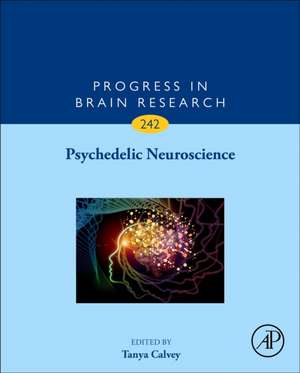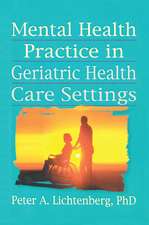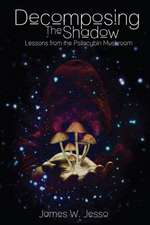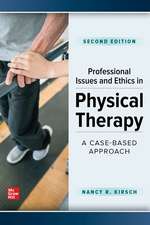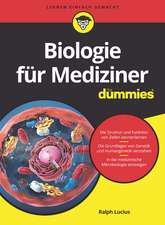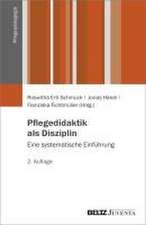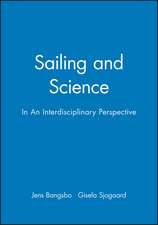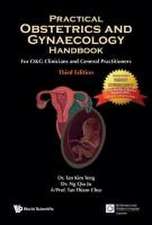Psychedelic Neuroscience: Progress in Brain Research, cartea 242
Editat de Tanya Calveyen Limba Engleză Hardback – 26 noi 2018
- This volume is a collection of chapters by world leaders in fields of neurobiology, neuropsychiatry, psychology, ethnography and pharmacology, addressing the neurobiological mechanisms of action of various classic and atypical psychedelics, their therapeutic potential as well as the possible risks associated with their use
Din seria Progress in Brain Research
- 5%
 Preț: 1615.08 lei
Preț: 1615.08 lei - 39%
 Preț: 1230.29 lei
Preț: 1230.29 lei - 9%
 Preț: 1232.44 lei
Preț: 1232.44 lei - 9%
 Preț: 1232.44 lei
Preț: 1232.44 lei - 5%
 Preț: 1281.30 lei
Preț: 1281.30 lei - 9%
 Preț: 1226.58 lei
Preț: 1226.58 lei - 5%
 Preț: 1281.42 lei
Preț: 1281.42 lei - 9%
 Preț: 1229.83 lei
Preț: 1229.83 lei - 9%
 Preț: 1232.44 lei
Preț: 1232.44 lei - 9%
 Preț: 1226.78 lei
Preț: 1226.78 lei - 32%
 Preț: 1228.99 lei
Preț: 1228.99 lei - 32%
 Preț: 1233.29 lei
Preț: 1233.29 lei - 29%
 Preț: 1283.57 lei
Preț: 1283.57 lei - 29%
 Preț: 1215.87 lei
Preț: 1215.87 lei - 32%
 Preț: 1154.95 lei
Preț: 1154.95 lei - 9%
 Preț: 1154.27 lei
Preț: 1154.27 lei - 9%
 Preț: 1151.54 lei
Preț: 1151.54 lei - 9%
 Preț: 1164.52 lei
Preț: 1164.52 lei - 9%
 Preț: 1160.07 lei
Preț: 1160.07 lei - 5%
 Preț: 1207.95 lei
Preț: 1207.95 lei - 32%
 Preț: 1161.07 lei
Preț: 1161.07 lei - 32%
 Preț: 1157.18 lei
Preț: 1157.18 lei - 5%
 Preț: 2062.98 lei
Preț: 2062.98 lei - 9%
 Preț: 1155.98 lei
Preț: 1155.98 lei - 9%
 Preț: 1164.43 lei
Preț: 1164.43 lei - 9%
 Preț: 1164.43 lei
Preț: 1164.43 lei - 9%
 Preț: 1158.65 lei
Preț: 1158.65 lei - 9%
 Preț: 1164.50 lei
Preț: 1164.50 lei - 9%
 Preț: 1149.16 lei
Preț: 1149.16 lei - 9%
 Preț: 1159.43 lei
Preț: 1159.43 lei - 5%
 Preț: 1214.52 lei
Preț: 1214.52 lei - 9%
 Preț: 1153.55 lei
Preț: 1153.55 lei - 9%
 Preț: 1156.91 lei
Preț: 1156.91 lei - 9%
 Preț: 1156.05 lei
Preț: 1156.05 lei - 9%
 Preț: 1159.50 lei
Preț: 1159.50 lei - 9%
 Preț: 1156.91 lei
Preț: 1156.91 lei - 5%
 Preț: 1205.96 lei
Preț: 1205.96 lei - 9%
 Preț: 1161.24 lei
Preț: 1161.24 lei - 41%
 Preț: 1084.00 lei
Preț: 1084.00 lei - 9%
 Preț: 1221.36 lei
Preț: 1221.36 lei - 29%
 Preț: 1212.66 lei
Preț: 1212.66 lei
Preț: 1159.33 lei
Preț vechi: 1273.99 lei
-9% Nou
Puncte Express: 1739
Preț estimativ în valută:
221.91€ • 241.12$ • 186.52£
221.91€ • 241.12$ • 186.52£
Carte în stoc
Livrare din stoc 11 martie
Preluare comenzi: 021 569.72.76
Specificații
ISBN-13: 9780128142554
ISBN-10: 0128142553
Pagini: 261
Dimensiuni: 191 x 235 x 21 mm
Greutate: 0.68 kg
Editura: ELSEVIER SCIENCE
Seria Progress in Brain Research
ISBN-10: 0128142553
Pagini: 261
Dimensiuni: 191 x 235 x 21 mm
Greutate: 0.68 kg
Editura: ELSEVIER SCIENCE
Seria Progress in Brain Research
Public țintă
This volume will interest policy makers, mental health practitioners, neuroscience researchers, researchers from various fields of health science and the humanities, members of the public and psychonauts.Cuprins
1. An introduction to psychedelic neuroscience
Tanya Calvey and Fleur M. Howells
2. The renaissance in psychedelic research: What do preclinical models have to offer
Kevin S. Murnane
3. D-Lysergic acid diethylamide, psilocybin, and other classic hallucinogens: Mechanism of action and potential therapeutic applications in mood disorders
Danilo De Gregorio, Justine P. Enns, Nicolas A. Nuñez, Luca Posa and Gabriella Gobbi
4. Common neural signatures of psychedelics: Frequency-specific energy changes and repertoire expansion revealed using connectome-harmonic decomposition
Selen Atasoy, Jakub Vohryzek, Gustavo Deco, Robin L. Carhart-Harris and Morten L. Kringelbach
5. A case report SPECT study and theoretical rationale for the sequential administration of ibogaine and 5-MeO-DMT in the treatment of alcohol use disorder
Joseph Barsuglia, Martin Polanco, Robert Palmer, Benjamin Malcolm, Benjamin Kelmendi and Tanya Calvey
6. Advances and challenges in neuroimaging studies on the effects of serotonergic hallucinogens: Contributions of the resting brain
Felix Müller, Matthias E. Liechti, Undine E. Lang and Stefan Borgwardt
7. Neurocognitive effects of cannabis: Lessons learned from human experimental studies
Marco Colizzi and Sagnik Bhattacharyya
8. Ibogaine as a treatment for substance misuse: Potential benefits and practical dangers
John Martin Corkery
Tanya Calvey and Fleur M. Howells
2. The renaissance in psychedelic research: What do preclinical models have to offer
Kevin S. Murnane
3. D-Lysergic acid diethylamide, psilocybin, and other classic hallucinogens: Mechanism of action and potential therapeutic applications in mood disorders
Danilo De Gregorio, Justine P. Enns, Nicolas A. Nuñez, Luca Posa and Gabriella Gobbi
4. Common neural signatures of psychedelics: Frequency-specific energy changes and repertoire expansion revealed using connectome-harmonic decomposition
Selen Atasoy, Jakub Vohryzek, Gustavo Deco, Robin L. Carhart-Harris and Morten L. Kringelbach
5. A case report SPECT study and theoretical rationale for the sequential administration of ibogaine and 5-MeO-DMT in the treatment of alcohol use disorder
Joseph Barsuglia, Martin Polanco, Robert Palmer, Benjamin Malcolm, Benjamin Kelmendi and Tanya Calvey
6. Advances and challenges in neuroimaging studies on the effects of serotonergic hallucinogens: Contributions of the resting brain
Felix Müller, Matthias E. Liechti, Undine E. Lang and Stefan Borgwardt
7. Neurocognitive effects of cannabis: Lessons learned from human experimental studies
Marco Colizzi and Sagnik Bhattacharyya
8. Ibogaine as a treatment for substance misuse: Potential benefits and practical dangers
John Martin Corkery
